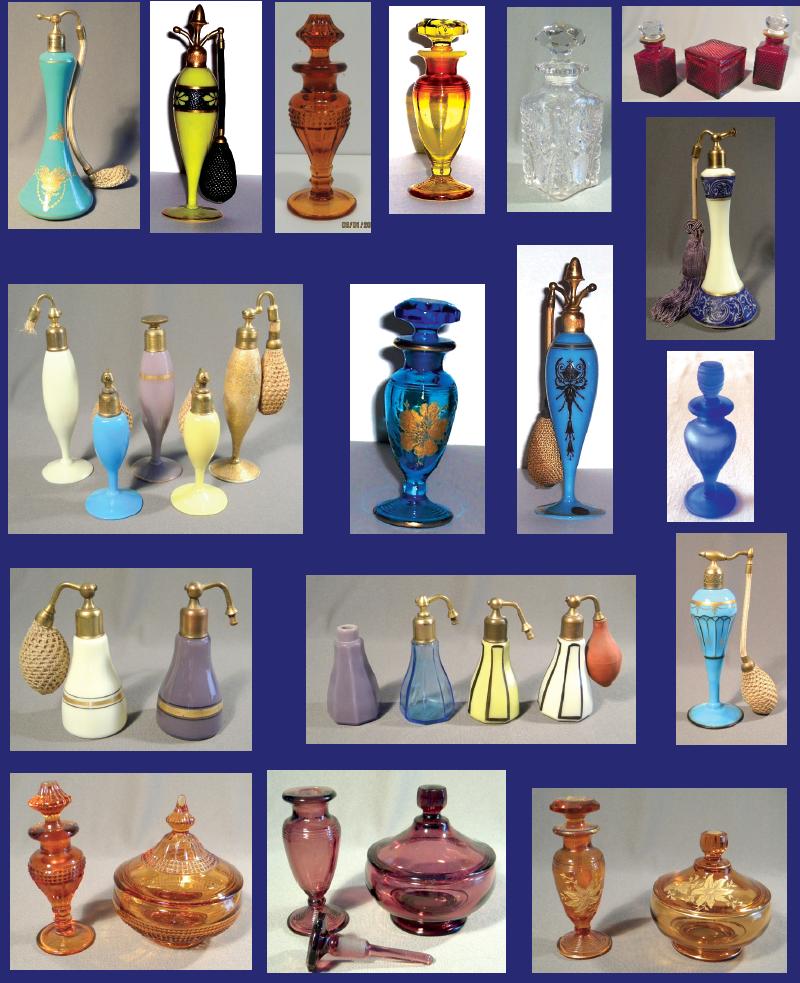Cambridge Perfume Bottles
by Mark Nye
Issue No. 440 - August 2010
"Perfume – aroma produced by the essential oils of plants and by synthetic aromatics. The burning of incense that accompanied the religious rites of ancient China, Palestine and Egypt led gradually to the personal use of perfume. In Greece where flower scents were first developed, the use of perfume became widespread. In Rome perfume was used extravagantly. In the Middle Ages, the Crusaders brought the knowledge of perfumery back to Europe from the East. Italian perfumers settled in Paris after 1500 and thereafter France became the leader of the perfume industry. After 1500 scents became fashionable….Each wealthy household had a 'still room' where perfume was prepared by the women." From The New Columbia Encyclopedia, 1975.
It is almost a given that from the beginnings of the making of glass and objects made from glass, containers to hold perfume were produced by these early predecessors of the glass companies familiar to us today. Perfumers had to have containers to hold their products and in which to sell them. Good perfumes have never been inexpensive and the end users, of all time periods, would have wanted decorative bottles to hold the fragrances. Hence, from the beginning of the glass industry, many of the better glass houses included in their product lines, perfume bottles. The Cambridge Glass Company was no exception as it produced a number of perfume bottles in assorted sizes, shapes and colors. This article will take a look at the history of perfume or cologne bottles and perfume atomizer bottles manufactured by Cambridge and sold under their label or sold in bulk to other companies who then added atomizers and sold the items under their label. These perfume containers often remain quite recognizable as being made by the Cambridge Glass Co. because of their color, shape and decoration.
The first illustration of a Cambridge scent container appeared in a catalog issued circa 1916 as part of a line captioned in the catalog as "No. 2590 Design Plain - Pressed and Iron Mold Blown Ware." The item itself was captioned "3 oz. cologne, G. S." It was a plain short cylindrical bottle with a ground stopper and, if found today, would be extremely difficult, if not impossible to identify as having been made by Cambridge. It is also very possible this line was not original to Cambridge, the molds having been brought there some years earlier from a National Glass Co factory.
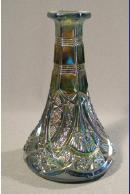 In this same circa 1916 catalog is the
Wheat Sheaf or No. 2660 line. One
of the items shown with this line was
a "Tall Decanter or Cologne." This
can be seen in a Carnival finish in the
photograph at the left. Likewise a "6
oz. Tall Cologne Bottle and Stopper"
is shown as a part of the No. 2699 or Buzz Saw Design.
In this same circa 1916 catalog is the
Wheat Sheaf or No. 2660 line. One
of the items shown with this line was
a "Tall Decanter or Cologne." This
can be seen in a Carnival finish in the
photograph at the left. Likewise a "6
oz. Tall Cologne Bottle and Stopper"
is shown as a part of the No. 2699 or Buzz Saw Design.
One of the items making up the No. 2351 Design, a heavy
pressed line, was a rectangular shaped cologne bottle and
stopper offered in 8 and 12 oz. sizes.
On a page entitled "Glass
Containers" from this same 1916
catalog are two jugs, each available
in 2 and 4 ounce sizes. Bearing
the catalog nos. 2669, 2675, 2667
and 2668 these were simply called
"jugs" but most certainly could
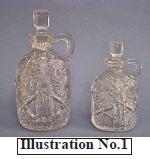 have been used as containers for
cologne or other scents. Nos. 2669
and 2675 have a single handle and are illustrated here. See
Illustration No. 1. Nos. 2667 and 2668 differ in that each
has two small handles located just below the neck.
The last of the Nearcut Era catalogs, carrying the designation
"Catalog No 10" was issued circa 1920. Among the
featured lines in this catalog was Chelsea, its only catalog
appearance, and Community or No. 2800. While the
Chelsea line did not offer a cologne bottle, the No. 2800 line
did, a 7 oz. cologne similar in appearance to the 7 oz. squat
oil.
have been used as containers for
cologne or other scents. Nos. 2669
and 2675 have a single handle and are illustrated here. See
Illustration No. 1. Nos. 2667 and 2668 differ in that each
has two small handles located just below the neck.
The last of the Nearcut Era catalogs, carrying the designation
"Catalog No 10" was issued circa 1920. Among the
featured lines in this catalog was Chelsea, its only catalog
appearance, and Community or No. 2800. While the
Chelsea line did not offer a cologne bottle, the No. 2800 line
did, a 7 oz. cologne similar in appearance to the 7 oz. squat
oil.
Among the items illustrated on a page in Catalog No. 10 that carried the caption "Oil Bottles" were several colognes. Among these were two sizes of the No. 2742 cologne, 3 and 7 ounces; the No. 2660/108 6 oz. tall cologne and the 2699/108 6 oz. tall cologne.
The next page in this same catalog was captioned "PRESSED AND CUT NOVELTIES." This page offered shakers, toothpicks, mustards, salt dips, knife rests, horseradish bottles and leading the page, colognes, fifteen of them as a matter of fact. Among these was three of the same design in different sizes, the Nos. 2912, 2913 and 2914. Later one of these is shown with the Mt. Vernon line, as the No. 1340 2½ ounce cologne.
It is in this catalog, No. 10, that we find the first etched Cambridge cologne bottles. Decorated with the etching Wedgewood are two bottles, the No. 16 4 oz. cologne and the No. 17 8 oz. cologne. Shown next to these bottles was the No. 15 Puff Box and Cover, also etched Wedgewood.
The majority of Cambridge perfumes found today, with the exception of the 3400/97 which will be discussed later, appear to have been produced in the 1920s. These were the years Cambridge was changing from a manufacturer of heavy pressed ware, the Nearcut Lines and utilitarian wares, to a maker of tableware whose shapes mirrored that made in china and porcelain, fancy stemware and decorative accessories. Apparently no general catalog was issued between 1921 and 1927 and it was in this time period most of the Cambridge perfume bottles were conceived and first brought to market. This time period attribution is based on the colors in which Cambridge perfumes are found along with how they are decorated.

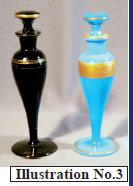 During the spring of 1927 Cambridge issued a new general
line catalog and in it were several perfume bottles with
dauber stoppers. Seen in this catalog are the 585 ½ oz.
perfume, Illustration No. 2, the 199 1 oz. (not shown) and
the 206-1½ oz perfume, Illustration No. 3. As shown
in the catalog the latter two are pictured with a No. 682
stopper. This is not the stopper seen in Illustration 3. There
apparently were a number of different stoppers that could
be used interchangeably with several bottles. Later in 1927
supplemental pages to the original
catalog were issued and it is on one of
these the 575 perfume and a matching
During the spring of 1927 Cambridge issued a new general
line catalog and in it were several perfume bottles with
dauber stoppers. Seen in this catalog are the 585 ½ oz.
perfume, Illustration No. 2, the 199 1 oz. (not shown) and
the 206-1½ oz perfume, Illustration No. 3. As shown
in the catalog the latter two are pictured with a No. 682
stopper. This is not the stopper seen in Illustration 3. There
apparently were a number of different stoppers that could
be used interchangeably with several bottles. Later in 1927
supplemental pages to the original
catalog were issued and it is on one of
these the 575 perfume and a matching
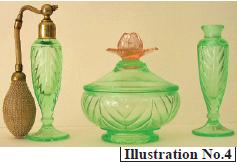 puff box, 576, is seen. This same style perfume was also
converted into an atomizer. Illustration No. 4. While
most Cambridge perfume bottles lend themselves to be
decorated, because of
its patterned surface,
the No. 575 perfume
bottle does not.
puff box, 576, is seen. This same style perfume was also
converted into an atomizer. Illustration No. 4. While
most Cambridge perfume bottles lend themselves to be
decorated, because of
its patterned surface,
the No. 575 perfume
bottle does not.
The Cambridge
opaque colors
preceded the pastel
transparent colors;
the first opaque color, Azurite, was
introduced in 1922. Following Azurite, the next several
years saw the introduction of Primrose Yellow, Helio, Ivory,
Jade and Cararra. These opaque colors, as well as Ebony,
were used extensively during the 1920s in the production of
perfume bottles and bottles for perfume atomizers. Many
of these bottles were decorated with the etchings of the era
and then gold, silver or enamel encrusted. Because of the
size of perfume bottles, in some instances only a portion
of an etching was used but these etchings remain readily
identifiable. In addition, hand painted enamel decorations
were used to decorate perfume bottles.
Since there are no
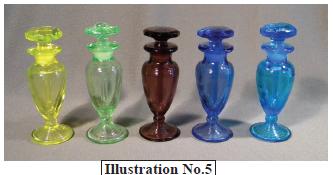 written records of these hand painted enamel decorations,
it is possible some were done after the bottles left the
Cambridge factory.
written records of these hand painted enamel decorations,
it is possible some were done after the bottles left the
Cambridge factory.
With the coming of the pastel transparent colors, these were also used to produce perfume bottles. An example of a perfume bottle may be found in most, if not all, of the transparent colors that made their initial appearances in the 1920s and 1930s. Examples of the No. 198 cologne bottle in several of these colors may be seen in Illustration 5. Production and sales records from the 1920s and early 1930s are almost non-existent. However, it is readily apparent that the peak period for the production of perfume bottles by Cambridge was in the 1920s. The one available catalog from this time period does not begin to tell the history of Cambridge perfumes.
It was long thought Cambridge produced only the glass portion of perfume atomizers, decorated as specified by the buyer, and then sold the bottles to another company who in turn added the atomizer and sold the final product under their label. Recent excavations on the Cambridge factory site have unearthed perfume bottles with the metal top fitting applied. To date the bottles found all have a broken foot, indicating perhaps the foot was damaged during the process of applying the metal fitting. Initial studies of the fittings indicate they are not of the quality seen on atomizers from Devilbiss and similar companies. None have been found with the metal tube screwed into the top.
Based on these
findings it appears, that in some instances, Cambridge at
least applied the metal top fitting to atomizer bottles. To
what extend Cambridge may have completed the atomizers
and sold them under their own label or were they attaching
the tops for another company are unanswered questions.
Regardless of what company added the atomizer, many
Cambridge produced perfumes are readily recognized as
Cambridge based on the criteria of color, shape and or
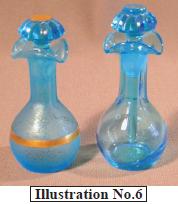 decoration. A number of different etchings, or portions
thereof, will be found on perfume atomizers and if on
opaque glass, they will be metal or enamel encrusted.
decoration. A number of different etchings, or portions
thereof, will be found on perfume atomizers and if on
opaque glass, they will be metal or enamel encrusted.
Take note of the two perfumes
seen in Illustration No.6. They
are of the same style but one
appears larger than the other and
they have different stoppers.
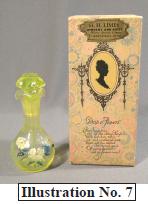 The one on the right has a
longer neck, contributing to the
appearance of it being a larger
bottle when in fact, it may not
be, capacity wise. The stoppers
have been finished differently.
The "top knot" of the stopper on
the left has been ground off and the surface painted with
gold while the one on the right retains its "top knot." This
same style perfume is also seen in
Illustration No.7, in Topaz with
hand painted flowers.
The one on the right has a
longer neck, contributing to the
appearance of it being a larger
bottle when in fact, it may not
be, capacity wise. The stoppers
have been finished differently.
The "top knot" of the stopper on
the left has been ground off and the surface painted with
gold while the one on the right retains its "top knot." This
same style perfume is also seen in
Illustration No.7, in Topaz with
hand painted flowers.
Four No. 585 perfumes are seen on
the left side of Illustration No.8,
while the one on the extreme right
is a larger size bottle in Topaz that
has been frosted and then decorated
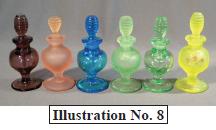 with enamel flowers. Two types
of the "bee hive" stopper are
illustrated in this picture.
Left to right Nos. 1, 3,
4 & 5 have the same
stopper while No. 2 has
a different version. It is
also different than the
with enamel flowers. Two types
of the "bee hive" stopper are
illustrated in this picture.
Left to right Nos. 1, 3,
4 & 5 have the same
stopper while No. 2 has
a different version. It is
also different than the
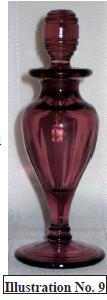 stopper found on the
Kresge bottle.
stopper found on the
Kresge bottle.
According to the Whitmyers, in their book "Bedroom and Bathroom Glassware of The Depression Years," Cambridge produced for the S. S. Kresge Company a perfume bottle with a "bee hive" style stopper in at least four transparent colors, Cobalt, Peach-Blo, Light Emerald and Amber. These bottles on occasion may be found with the Kresge label still intact. That Cambridge produced these bottles cannot be confirmed from private mold records. The "bee hive" style stopper found on these bottles appears to be shorter than the one found on the Cambridge No. 585 perfume as seen in the 1927 Cambridge but is of the same general style. It does have a relatively wide plain band in the top half while the Cambridge stopper has concentric rings /ridges from top to bottom of the stopper head. An Amethyst bottle very similar to the "Kresge" bottle having the same style stopper has been reported by a NCC member and is shown in Illustration No. 9. This one has faint rings on the foot while the original description of the Kresge bottle implied the foot was plain.
The Cambridge private mold listing does include a number of bottles for Gironde, Devilbiss and Van Woud as well as for Dupont Visacloid Company, Irving Rice & Company, Jor Jorian Brothers and Globe Art. Unfortunately, the descriptions provided are minimal and there is no way of knowing what these bottles may have looked like. Recognizing them as Cambridge, if at all possible, will have to be based on known Cambridge colors and decorations.
1930 saw the issuance of a new catalog and
for the next four to five years, supplements
to this catalog continued to be issued. New
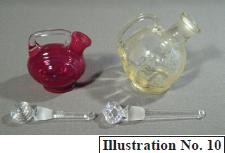 to this catalog was the 3400 line and with it
came the 3400/97 two ounce perfume. The
3400/97 perfume can
be seen in Illustration
No. 10 to the right of
the Carmen Nautilus
perfume. Lying in
front of it is the dauber
stopper, complete with
keyhole head, that
was original to the perfume. When
originally sold as the perfume, the
3400/97 2 oz ball shaped bottle would have had the dauber
stopper. This same piece was also listed as the 2 oz oil
(vinegar) but as such was sold with a keyhole stopper
without a dauber.
to this catalog was the 3400 line and with it
came the 3400/97 two ounce perfume. The
3400/97 perfume can
be seen in Illustration
No. 10 to the right of
the Carmen Nautilus
perfume. Lying in
front of it is the dauber
stopper, complete with
keyhole head, that
was original to the perfume. When
originally sold as the perfume, the
3400/97 2 oz ball shaped bottle would have had the dauber
stopper. This same piece was also listed as the 2 oz oil
(vinegar) but as such was sold with a keyhole stopper
without a dauber.
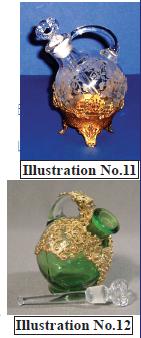 A 1932 supplemental page carried an
illustration of the 3400/97 2 oz cologne
(perfume) with a keyhole stopper etched
Portia. On another 1932 page, this one
featuring Rock Crystal Engravings, is
found a dresser set consisting of two of
the 3400/97 colognes and the 3400/94 puff
box sitting on 660 tray, all engraved No.
639. The collector should not be surprised
to find a 3400/94 perfume decorated with
any etching normally associated with
the 3400 line.
A 1932 supplemental page carried an
illustration of the 3400/97 2 oz cologne
(perfume) with a keyhole stopper etched
Portia. On another 1932 page, this one
featuring Rock Crystal Engravings, is
found a dresser set consisting of two of
the 3400/97 colognes and the 3400/94 puff
box sitting on 660 tray, all engraved No.
639. The collector should not be surprised
to find a 3400/94 perfume decorated with
any etching normally associated with
the 3400 line.
During the 1930s, one or more makers of metal filigree work purchased the 3400/97 cologne, added their trim and sold the resulting perfumes and/or dresser sets under their label. Examples of such pieces are seen in Illustrations Nos. 11 & 12.
The original 1930 Cambridge Catalog consisted of seventy
one pages, one of which was devoted to "Bathroom Bottles"
including one etched "Toilet Water." These bottles are well
known to Cambridge collectors and no further discussion of
them will be given in this article.
Included with the Mount Vernon Line
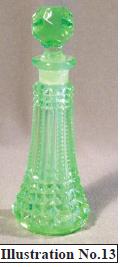 which made its debut in the 1932 catalog
supplement is the earlier 1340 2½ oz
cologne bottle. An example of this bottle,
in light Emerald, is seen in Illustration
No. 13.
which made its debut in the 1932 catalog
supplement is the earlier 1340 2½ oz
cologne bottle. An example of this bottle,
in light Emerald, is seen in Illustration
No. 13.
1934 saw the line Nautilus featured in a
catalog supplement and included in this
rather small line was a 1½ oz perfume
with a ground dauber stopper. A Carmen
example may be seen in Illustration No.
14 as well as in Illustration No. 10.
A catalog page issued after 1934
offered the 3400/97 perfume in
Crystal, Amber, Dianthus Pink,
Moonlight, Forest Green, Royal
Blue and Amethyst. It no doubt
had been available in the listed
colors prior to 1935 and as a
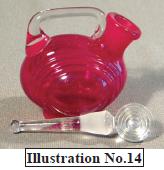 perfumes, would have been sold
with a dauber stopper.
perfumes, would have been sold
with a dauber stopper.
For the next twenty years, until the demise of the original Cambridge Glass Company, new lines did not include a perfume or cologne bottle. The 1940 Cambridge catalog continued to offer the 3400/97 perfume, plain or etched Diane, Portia, and Elaine. In prior years, it had also been etched Rose Point. The original Cambridge Glass Co. issued its last catalog in the summer of 1949 and perfumes were no longer included in the Cambridge line.
For reason or reasons yet to be determined, many old and no longer used molds were destroyed in 1940. (This occurred before the U.S. involvement in WW II and its scrap metal drives.) Included in the lists of molds destroyed were a number of molds for "cologne bottles" and "cologne stoppers." Among the cologne molds destroyed were those for Nos.198, 199, 204, 206, 207, 208, 585, 586, 589, 665, 833 and associated stoppers or in some instances stoppers alone such as Nos. 196, 205, 593, 682, and 831.
While not a holder of perfume for personal use, a related item
is the perfume lamp. A small lamp providing only a small
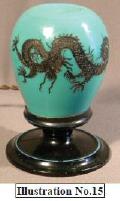
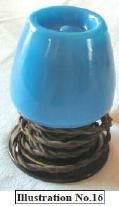 amount of light, its primarily purpose was to add a pleasant
scent to its surroundings. Perfume was added to the well
located on top of the lamp and heat from the bulb contained
inside the "shade" vaporized the perfume. From the 1920s,
these will be found in opaque colors from that period and
with metallic and enamel encrustations of etchings from the
same years. Two examples of Cambridge perfume lamps can
be seen in Illustrations Nos. 15 & 16.
amount of light, its primarily purpose was to add a pleasant
scent to its surroundings. Perfume was added to the well
located on top of the lamp and heat from the bulb contained
inside the "shade" vaporized the perfume. From the 1920s,
these will be found in opaque colors from that period and
with metallic and enamel encrustations of etchings from the
same years. Two examples of Cambridge perfume lamps can
be seen in Illustrations Nos. 15 & 16.
A number of atomizers not specifically referenced in the text of this article are illustrated on a separate page. Cambridge attribution is based on color and decoration but most were probably sold under a different label. The bottles would have been made by Cambridge under contract with another company who either supplied the finished mold or the mold design.
Long out of print, Bedroom & Bathroom Glassware of the Depression Years by Margaret and Kenn Whitmyer and published by Collectors Books, remains the best illustrated reference for Cambridge perfumes. If not already in your library, serious collectors of Cambridge perfumes, as well as those made by other companies, should not pass up an opportunity to acquire a copy.
A very special "thank you" to the following Friends
of Cambridge who contributed photos for the
"Cambridge Perfume Bottles" article in this issue.
Sue Cameron
Mike Horine
Kay Larsson
Linda Roberts
Frank & Vicki Wollenhaupt
